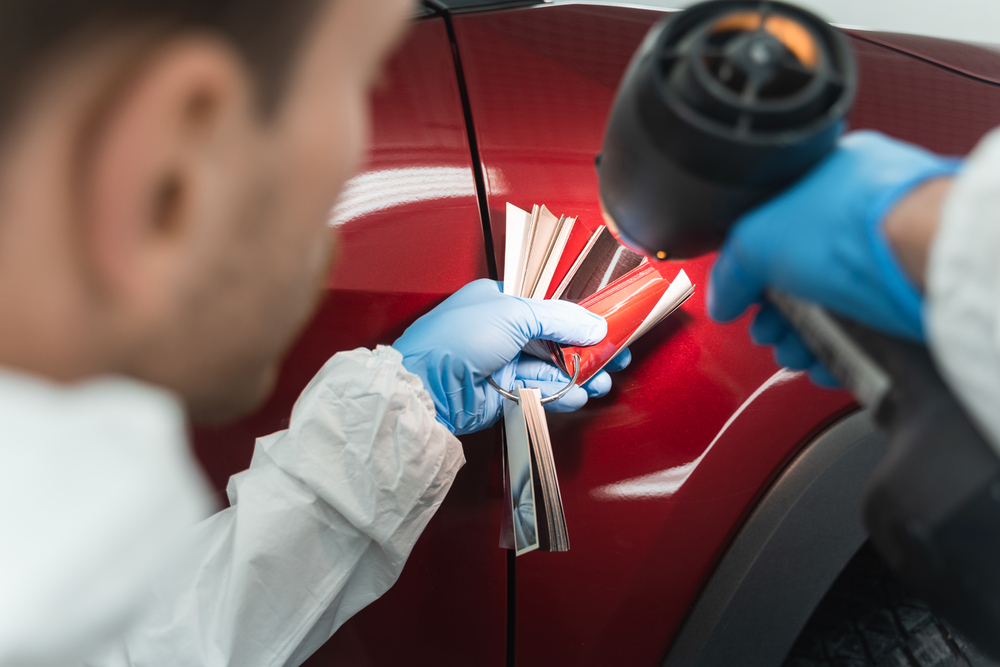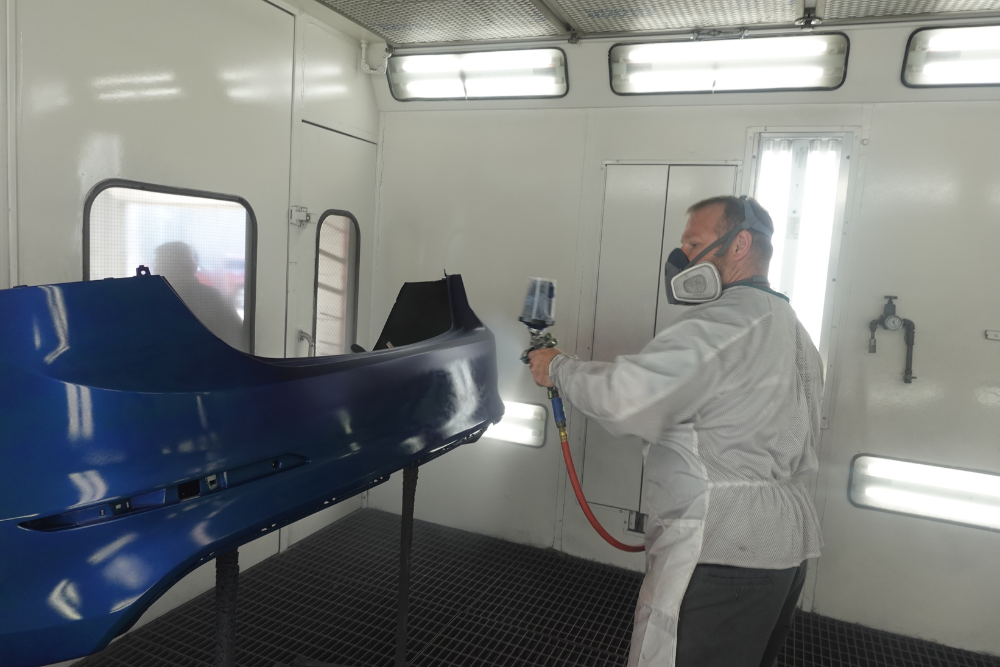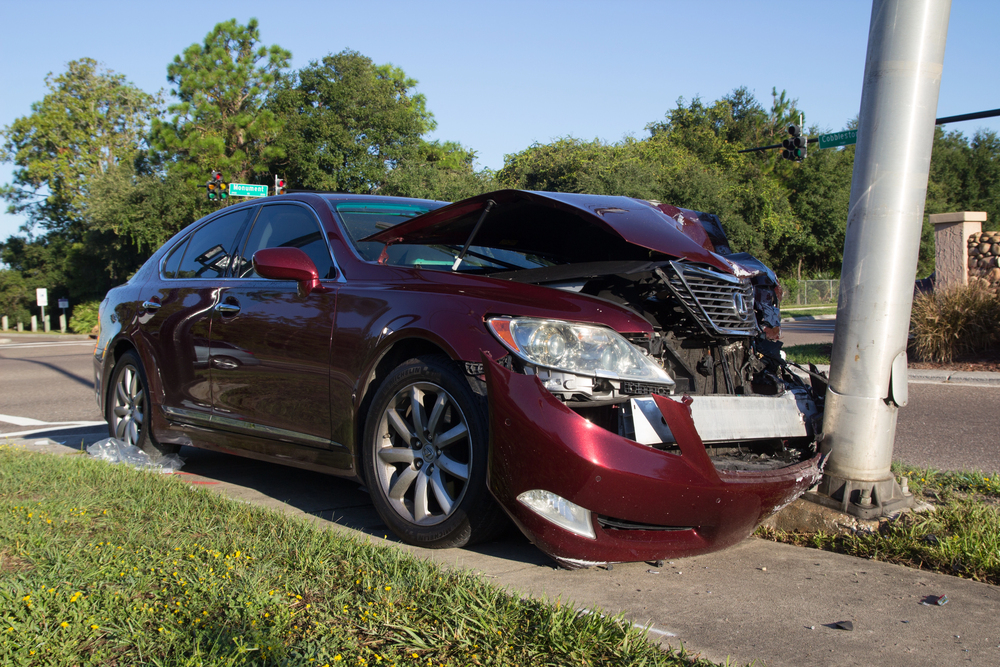When you see a beautifully restored car gleaming in the sunlight, have you ever wondered how auto body shops achieve that perfect, seamless color match? At Elmer’s Auto Body in Marlton, color matching is both an art and a science, combining cutting-edge technology with human expertise to deliver stunning results. Let’s take a deep dive into the fascinating world of automotive color matching.
The Importance of Color Matching in Auto Body Repair
Color matching is critical in auto body repair for several reasons. First and foremost, it ensures that your vehicle looks as good as new after repairs, maintaining its aesthetic appeal and value. A poor color match can be glaringly obvious, detracting from the overall appearance of your car and potentially reducing its resale value.
Moreover, accurate color matching is essential for preserving the original design and character of your vehicle. Car manufacturers put considerable thought into their color choices, and a precise match helps maintain the integrity of that design.
A Brief History of Automotive Paint Technology
The evolution of automotive paint technology is a testament to human ingenuity. In the early days of the automobile industry, cars were painted by hand using brushes and basic paints. This process was time-consuming and often resulted in inconsistent finishes.
The 1920s saw the introduction of spray painting, which revolutionized the industry by allowing for faster, more uniform application. In the 1960s, the development of metallic paints added depth and shine to car finishes, while the 1980s brought about the introduction of clear coat technology, providing better protection and a glossier finish.
Today, we have highly advanced paints with special effects like color-shifting pigments and self-healing properties. These innovations have made color matching both more complex and more precise.
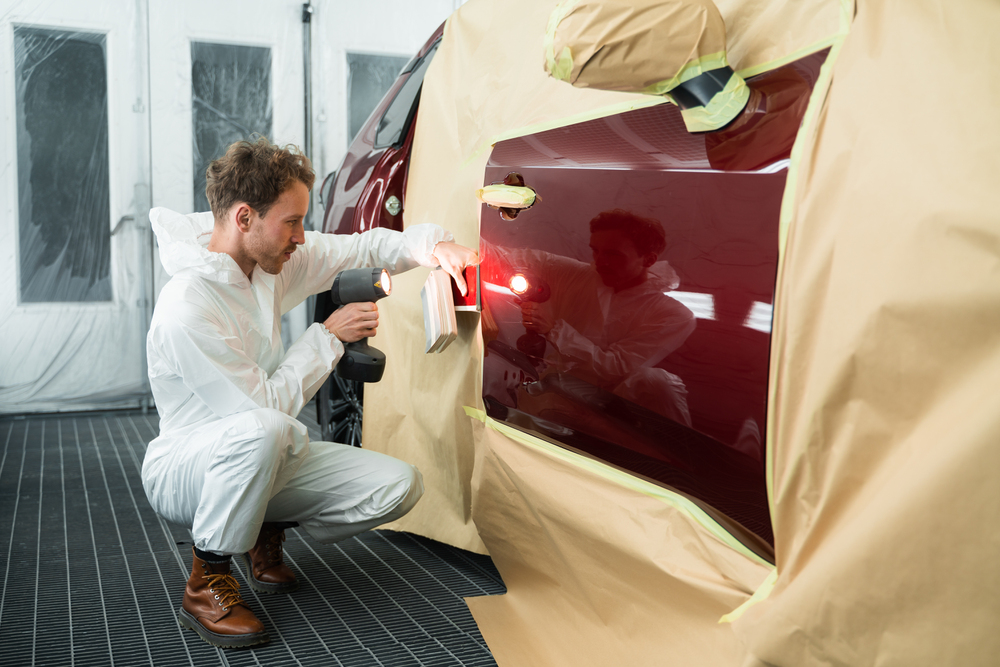
Elmer’s Auto Body’s Reputation in Marlton for Color Matching Expertise
At Elmer’s Auto Body in Marlton, we’ve built our reputation on our ability to achieve perfect color matches, regardless of the complexity of the paint. Our team combines years of experience with state-of-the-art technology to ensure that every repaired vehicle leaves our shop looking indistinguishable from its pre-damage condition.
The Science Behind Color Matching
Understanding the Physics of Color
To truly appreciate the complexity of color matching, it’s essential to understand the basics of color physics. Color, as we perceive it, is the result of light interacting with objects and our eyes.
- Light Spectrum and Color Perception: Visible light is a small part of the electromagnetic spectrum. When light hits an object, some wavelengths are absorbed while others are reflected. Our eyes perceive these reflected wavelengths as color. For example, a red car appears red because it reflects red wavelengths while absorbing others.
- Metamerism and its Impact on Color Matching: Metamerism is a phenomenon where two colors appear identical under one light source but different under another. This is crucial in color matching because a paint that looks perfect in the shop might look different outdoors. At Elmer’s, we use multiple light sources to ensure our color matches look great in all conditions.
Types of Automotive Paints and Their Properties
Different types of automotive paints present unique challenges in color matching:
- Solid Colors: These are the simplest to match, consisting of a single, uniform color.
- Metallic Paints: These contain small metal flakes that reflect light, creating a sparkle effect. The challenge lies in matching both the base color and the metallic effect.
- Pearl and Special Effect Paints: These paints use special pigments that can change color depending on the viewing angle, making them particularly tricky to match.
The Role of Pigments and Binders in Paint Formulation
Automotive paints consist primarily of pigments (which provide color) and binders (which hold the pigments together and adhere to the vehicle’s surface). The exact ratio and type of pigments and binders used can significantly affect the final color and finish of the paint.
Advanced Color Matching Technology at Elmer’s Marlton
At Elmer’s Auto Body in Marlton, we employ cutting-edge technology to ensure precise color matches:
Spectrophotometers and Their Function
- How Spectrophotometers Work: These devices measure the exact wavelengths of light reflected from a surface. By analyzing these measurements, we can determine the exact color composition of the original paint.
- Advantages over Traditional Color Matching Methods: Spectrophotometers provide objective, numerical data about colors, eliminating the subjectivity of visual color matching and allowing for much more precise matches.
Computer-aided Color Formulation Systems
- Digital Color Libraries and Databases: We have access to extensive digital libraries containing thousands of color formulas from various manufacturers and model years.
- Software for Precise Color Mixing Ratios: Our advanced software uses the spectrophotometer data to calculate exact mixing ratios for pigments, ensuring a perfect match every time.
The Human Element: The Expertise of Elmer’s Color Technicians
While technology plays a crucial role, the expertise of our technicians is equally important:
- Training and Certification Programs: Our color matching specialists undergo rigorous training and certification to stay at the forefront of industry standards and techniques.
- The Importance of Experience and Intuition: Even with advanced technology, the human eye and the intuition that comes from years of experience are invaluable in achieving perfect color matches, especially for unique or challenging colors.
At Elmer’s Auto Body in Marlton, we’re passionate about the art and science of color matching. Our commitment to combining cutting-edge technology with human expertise ensures that your vehicle will look as good as new after repairs, preserving its beauty and value for years to come.
The Art of Color Matching
While science and technology play crucial roles in color matching, there’s an undeniable artistic element that sets apart truly exceptional work. At Elmer’s Auto Body in Marlton, we pride ourselves on mastering both the art and science of color matching.
Visual Assessment Techniques
- Lighting Conditions and Their Impact on Color Perception: Different lighting conditions can dramatically alter how we perceive color. Our technicians are trained to assess colors under various light sources, including natural daylight, fluorescent light, and LED light. This ensures that the color match looks perfect regardless of the lighting conditions.
- The Role of Color Memory and Communication: Describing colors accurately can be challenging. Our technicians have developed a keen color memory and use standardized color terminology to communicate effectively about subtle color variations. This skill is particularly valuable when working on custom or unique colors.
Customization and Creativity in Color Matching
- Dealing with Faded or Unique Factory Colors: Over time, vehicle paint can fade or change due to exposure to sunlight and environmental factors. Our team is adept at recreating the original color, taking into account the vehicle’s age and condition. For unique factory colors, we leverage our extensive color libraries and expertise to achieve precise matches.
- Creating Custom Colors for Specialty Projects: Sometimes, clients want something truly unique. Our color matching artists can create custom colors from scratch, turning your vision into reality. Whether it’s a one-of-a-kind hot rod or a personalized luxury vehicle, we can develop and apply custom colors that perfectly reflect your style.
Case Studies: Challenging Color Matches at Elmer’s Marlton
- Restoring a Vintage Car with Discontinued Paint: Recently, we worked on a 1965 Mustang with a rare factory color that had been discontinued decades ago. By combining our digital color library, spectrophotometer readings, and the expertise of our senior technicians, we were able to recreate the exact shade, bringing the classic car back to its original glory.
- Matching a Modern Car with Complex Pearlescent Finish: We faced a challenge with a 2023 luxury vehicle that had a complex pearlescent finish. This multi-layer paint job required precise color matching for each layer. Using our advanced technology and the skilled eyes of our technicians, we achieved a flawless match that was indistinguishable from the factory finish.
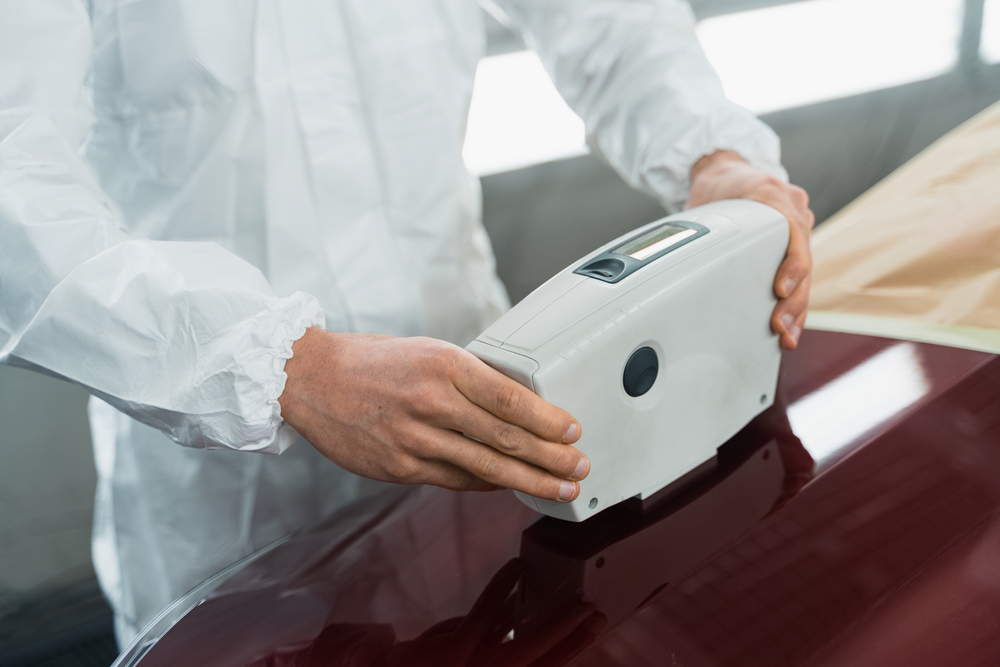
The Color Matching Process at Elmer’s Marlton
At Elmer’s, we follow a meticulous process to ensure perfect color matches every time:
Initial Assessment and Documentation
When a vehicle arrives at our shop, we thoroughly document its current condition, paying special attention to the areas requiring color matching. We take detailed photos and notes about the paint’s texture, sheen, and any unique characteristics.
Color Code Identification and Verification
We locate the vehicle’s color code, usually found on a label in the door jamb or under the hood. However, we don’t rely solely on this code, as there can be variations even within the same color code due to factors like different production batches or environmental exposure.
Paint Mixing and Testing
- The Sprayout Card Process: Once we’ve formulated a color match, we create a sprayout card – a sample of the mixed paint sprayed onto a card. This allows us to compare the new paint directly with the vehicle’s existing paint under various lighting conditions.
- Adjusting and Refining the Color Match: If the initial match isn’t perfect, our technicians make minute adjustments to the formula. This process may be repeated several times until we achieve an exact match.
Quality Control Measures
- Multiple Light Source Inspection: We inspect the color match under different light sources, including natural sunlight, fluorescent lights, and specialized color-matching lights. This ensures the match looks perfect in all conditions.
- Customer Approval Process: Before we proceed with the final paint application, we often invite the customer to inspect the color match. Your satisfaction is our top priority, and we want you to be confident in the results.
Environmental Considerations
At Elmer’s Auto Body, we’re committed to environmentally responsible practices in all aspects of our work, including our paint processes.
Eco-friendly Paint Options at Elmer’s Marlton
- Water-Based Paints: We use water-based paints whenever possible. These paints significantly reduce the emission of volatile organic compounds (VOCs) compared to traditional solvent-based paints, making them better for both the environment and our technicians’ health.
- Low-VOC Formulations: When water-based paints aren’t suitable for a particular job, we opt for low-VOC solvent-based paints. These advanced formulations provide excellent results while minimizing environmental impact.
Proper Disposal of Paint Materials
We follow strict guidelines for the disposal of paint materials. All leftover paint, solvents, and related materials are collected and disposed of through licensed waste management services, ensuring they don’t end up in landfills or water systems.
Energy-Efficient Paint Booth Technology
Our state-of-the-art paint booths are designed for maximum energy efficiency. They use advanced filtration systems to capture overspray and minimize emissions. The booths also feature energy-efficient lighting and climate control systems, reducing our overall energy consumption.
At Elmer’s Auto Body in Marlton, we’re proud to offer top-tier color matching services that blend artistry, cutting-edge technology, and environmental responsibility. Whether you’re restoring a classic car, repairing collision damage, or creating a custom look, you can trust our team to deliver flawless results that stand the test of time.
The Future of Color Matching at Elmer’s Auto Body
At Elmer’s Auto Body, we’re not just focused on perfecting our current techniques – we’re also looking ahead to the future of color matching. Our commitment to staying at the forefront of technology ensures that we’ll continue to provide the best possible service to our customers.
Emerging Technologies in Color Matching
- AI and Machine Learning Applications: We’re exploring the potential of artificial intelligence and machine learning in color matching. These technologies could revolutionize our ability to predict color changes due to aging and environmental factors, allowing for even more precise matches. AI could also help optimize paint formulations, reducing waste and improving efficiency.
- Augmented Reality for Previewing Color Options: We’re excited about the potential of augmented reality (AR) in our color matching process. In the near future, customers might be able to use an AR app to preview different color options on their vehicle before any paint is applied. This technology could be particularly useful for custom paint jobs or when deciding on a color change.
Continuous Training and Skill Development for Technicians
The auto body industry is constantly evolving, and so is our team. We invest heavily in ongoing training and skill development for our technicians. This includes:
- Regular workshops on new paint technologies and application techniques
- Certification programs to keep our team up-to-date with industry standards
- Hands-on training with the latest color matching equipment
Adapting to New Automotive Finishes and Materials
As car manufacturers introduce new types of finishes and materials, we’re committed to staying ahead of the curve. This includes:
- Researching and adopting techniques for matching matte and satin finishes
- Developing expertise in dealing with new composite materials used in modern vehicles
- Staying informed about advancements in self-healing and color-changing paints
Tips for Customers: Maintaining Your Vehicle’s Paint
While we’re always here to help with your auto body needs, proper maintenance can go a long way in preserving your vehicle’s paint. Here are some tips to keep your car looking its best:
Regular Cleaning and Waxing Routines
- Wash your car regularly, at least every two weeks, to remove dirt and contaminants that can damage the paint.
- Use a pH-neutral car shampoo and soft microfiber cloths to avoid scratching the surface.
- Apply a good quality car wax every 3-4 months to protect the paint and maintain its shine.
Protecting Your Car from Environmental Damage
- Park in a garage or use a car cover when possible to protect from sun damage and bird droppings.
- If you live in an area with harsh winters, wash your car more frequently to remove road salt, which can corrode the paint.
- Consider applying a ceramic coating for long-term protection against environmental contaminants.
When to Seek Professional Help for Paint Touch-ups
While minor scratches can sometimes be addressed at home, it’s best to seek professional help for:
- Deep scratches that go beyond the clear coat
- Large areas of paint damage or fading
- Any paint issues on newer vehicles that might still be under warranty
Remember, attempting DIY repairs on significant paint damage can often lead to more noticeable issues. When in doubt, consult with our professionals at Elmer’s Auto Body.
Conclusion
Recap of the Art and Science Behind Color Matching
Color matching in auto body repair is a fascinating blend of art and science. It requires a deep understanding of color theory, advanced technology, and a well-trained eye. From the physics of light and color to the latest in spectrophotometer technology, every aspect plays a crucial role in achieving that perfect match.
Elmer’s Marlton Commitment to Excellence in Auto Body Repair
At Elmer’s Auto Body in Marlton, we’re committed to excellence in every aspect of our work. Our investment in cutting-edge technology, ongoing training for our technicians, and our attention to detail ensure that every vehicle we work on receives the highest quality care. We’re not just fixing cars; we’re restoring them to their original beauty – or even better.
The Ongoing Evolution of Color Matching Technology and Techniques
The field of color matching is continuously evolving, and we’re evolving with it. From AI and machine learning to augmented reality, we’re always looking for ways to improve our processes and results. As new automotive finishes and materials emerge, we’re committed to staying ahead of the curve, ensuring we can handle any color matching challenge that comes our way.
Our journey through the world of color matching – from its basic principles to the latest technologies and future trends – showcases the complexity and precision involved in auto body repair. At Elmer’s Auto Body in Marlton, we bring together the art and science of color matching to deliver results that exceed expectations.
Whether you’re restoring a classic car, repairing collision damage, or looking to give your vehicle a fresh new look, you can trust Elmer’s Auto Body to provide expert color matching and superior auto body services. Our commitment to quality, combined with our forward-thinking approach, ensures that your vehicle is in the best hands possible.
Thank you for taking the time to learn about the intricate world of color matching with us. We look forward to serving you and your vehicle with the expertise and care you deserve.

